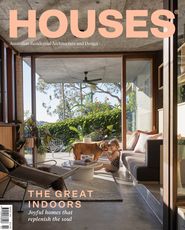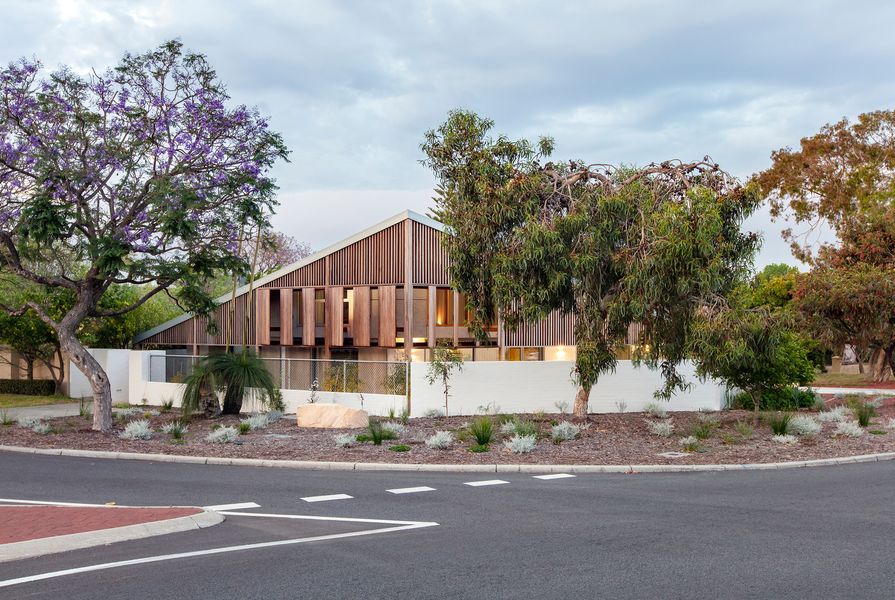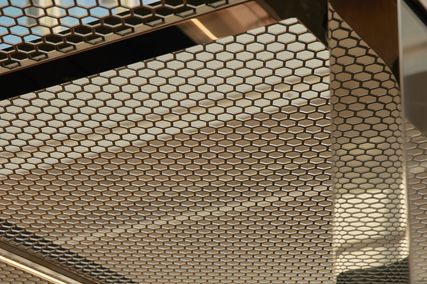There’s something special about the sunlight in Perth. Shepherding the day, it reaches the west coast having crossed Australia’s great land mass, ripening fruits in the wake of the Darling Scarp before puckering the bare shoulders of walkers, blinding evening beachgoers and, finally, resting beneath the Indian Ocean’s horizon. It is fierce and unforgiving, and yet its richness and clarity make it a daily source of joy. Perth residents Adam and Kerry had long envisaged a home that would welcome those conditions, one that would work with – rather than against – the generous Western Australian sun.
Technically minded and well-researched in passive solar design, seasoned renovators Adam and Kerry engaged Phil and the team at Philip Stejskal Architecture to realize their dream of an energy-efficient home that would effectively be a downsizer for the couple and their 15-year-old whippets, Joey and Bandit. Located in the riverside suburb of Applecross, the new house replaced a triplex whose siblings remain, clinging together on a neighbouring block, their low-lying brick-and-tile forms typical of Perth’s more established suburbs. Macdonald Road House occupies a corner site facing a roundabout that channels local traffic toward a quaint shopping village and, beyond, the river foreshore.
The ground floor operates much like a one-bedroom apartment, serving the clients’ desire to age in place.
Image: Bo Wong
For the new house to capitalize on the all-important spoils of a northern face, it had to embrace its prominent location and open up to the site’s public, rounded corner. This spawned an unusual parallelogram-shaped plan. “We were puzzling about how we were going to get the house to face north on this site,” says Kerry, who had initially wondered whether she and Adam were “brave enough” for the unusual plan proposed by Phil. “We drew a line where we needed to be, parallel to north,” Phil explains. “And it made sense to repeat or offset that line because that gave us a little courtyard at the back of the house.”
It might appear simple but this is a hard-working plan. The ground floor operates much like a one-bedroom apartment, while a smaller second storey for guest accommodation is tucked into the apex of the roofline. This arrangement, informed by the principles of universal access, serves Adam and Kerry’s desire to age in place, to have all they need now – and all they are likely to need in the future – on one level. It also allows the home’s roof to taper toward each single-storey neighbour, so as to avoid overpowering them in mass. The resulting geometry is at once modest and powerful, and it enhances the building’s dialogue with its community. Viewed from across the roundabout, the home’s tapering edges appear like arms opening to embrace the suburban village. A street-side vegetable garden and sections of chain mesh fence add to this friendly gesture.
A consistent palette of birch plywood, brick and polished concrete imparts a calming sense of cohesion throughout the home.
Image: Bo Wong
The home’s front garden doubles as its main outdoor living space, where publicness and privacy are brought into balance by a predominantly solid bagged brick wall, slivered here and there for subtle connection with the street. Phil and his team worked with long-time collaborator Annghi Tran Landscape Architecture Studio to create a garden of low-maintenance native plants set among limestone from Donnybrook in Western Australia’s south-west. A spotted gum verandah wraps around the home’s eastern and northern elevations and is poised to enjoy the garden as well as the cheerful chatter of passers-by.
Yet another hard-working element of the design, this verandah also mediates sunlight and associated heat, with operable jarrah shutters above ground level that can be closed to the ferocious summer sun and opened to invite gentler winter light inside. “The shutters are particularly important to our reinterpretation of the traditional verandah, improving it,” Phil says. “In a traditional farmhouse, the verandah works with the brickwork’s thermal mass to keep the interior cool in summer, but it doesn’t work particularly well in winter because of its low brim.” At Macdonald Road House, the operable shutters of the double-height verandah are part of the house’s clever passive solar design.
Operable jarrah shutters above the verandah can be closed to block the heat of summer and opened to admit gentler winter light.
Image: Bo Wong
Inside, the materials are simple and organic and make vernacular sense – requirements of Adam and Kerry’s brief. Crucial to the home’s passive solar ambitions, bricks are used for the ground-floor walls. Bagged and painted, they are judiciously set out in a hit-and-miss pattern (“a connection to the breezeblocks of the old sixties houses we love,” says Adam) in places where cross-breezes and ventilation can be optimized. Birch plywood joinery reoccurs throughout every space with a consistency that imparts a relaxed yet ordered sense of calm, as do the many apertures to the surrounding gardens.
Macdonald Road House represents something that Perth’s sprawling sunburnt suburbs need more of: homes that eschew the status quo with equal bouts of contemplation and bravery. Undoubtedly, part of this home’s success lies in its passive solar credentials, underpinned by a careful responsiveness to climate and a philosophy shared by both architect and client. But it also lies in the bravery of the clients to diminish their house’s footprint, to face the busy corner, to activate the front yard and to engage with the neighbours with wholeheartedness and humility.
Products and materials
- Roofing
- Fielders Prominence in Zincalume
- External walls
- Midland Brick Longreach bricks, bagged and painted; Fielders Prominence in Zincalume
- Internal walls
- Birch plywood from Worldwide Timber Traders in Osmo oil; CSR plasterboard; Midland Brick Longreach bricks, bagged and painted
- Windows
- Victorian ash from Worldwide Timber Traders in Cutek; Alspec aluminium frames, powdercoated; double-glazing
- Doors
- Alspec aluminium, powdercoated
- Flooring
- Burnished and sealed concrete; Signature Floors Victorian ash in Osmo oil
- Lighting
- Unios lights
- Kitchen
- Siemens Studio Line pyrolytic oven and induction cooktop; Schweigen rangehood; Miele dishwasher; Fisher and Paykel fridge
- Bathroom
- Tapware and fittings from Reece
- Heating and cooling
- Amuheat underfloor hydronic heating; Daikin heat-recovery ventilation system and ducted reverse-cycle airconditioner
- External elements
- Sandstone boulders and slabs; basalt gravel
Credits
- Project
- Macdonald Road House
- Architect
- Philip Stejskal Architecture
Fremantle, WA, Australia
- Project Team
- Louise Allen, Jaime Mayger, Julia Kiefer, Philip Stejskal
- Consultants
-
Builder
Portrait Custom Homes
Engineer Andreotta Cardenosa Consulting Engineers
Landscaping Annghi Tran Landscape Architecture Studio
Lighting HS Reflections
- Aboriginal Nation
- Macdonald Road House is built on the land of the Whadjuk Noongar people.
- Site Details
-
Location
Perth,
WA,
Australia
Site type Suburban
Site area 350 m2
Building area 173 m2
- Project Details
-
Status
Built
Completion date 2020
Design, documentation 18 months
Construction 18 months
Category Residential
Type New houses
Source

Project
Published online: 14 May 2021
Words:
Stephanie McGann
Images:
Bo Wong
Issue
Houses, April 2021



























